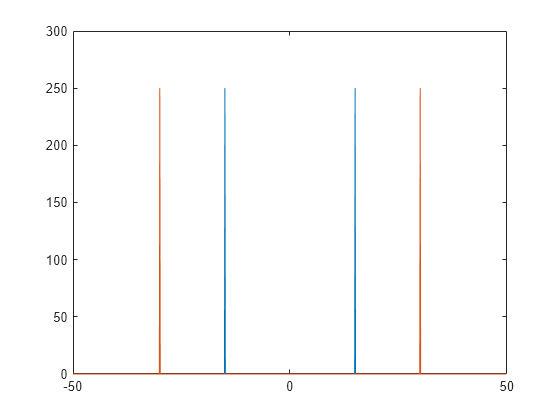fftshift - Shift zero-frequency component to center of spectrum - MATLAB (original) (raw)
Shift zero-frequency component to center of spectrum
Syntax
Description
Y = fftshift([X](#bviss0f-1-X)) rearranges a Fourier transform X by shifting the zero-frequency component to the center of the array.
- If
Xis a vector, thenfftshiftswaps the left and right halves ofX. - If
Xis a matrix, thenfftshiftswaps the first quadrant ofXwith the third, and the second quadrant with the fourth. - If
Xis a multidimensional array, thenfftshiftswaps half-spaces ofXalong each dimension.
Y = fftshift([X](#bviss0f-1-X),[dim](#bviss0f-1-dim)) operates along the dimension dim of X. For example, if X is a matrix whose rows represent multiple 1-D transforms, then fftshift(X,2) swaps the halves of each row of X.
Examples
Shift Vector Elements
Swap the left and right halves of a row vector. If a vector has an odd number of elements, then the middle element is considered part of the left half of the vector.
Xeven = [1 2 3 4 5 6]; fftshift(Xeven)
Xodd = [1 2 3 4 5 6 7]; fftshift(Xodd)
Shift 1-D Signal
When analyzing the frequency components of signals, it can be helpful to shift the zero-frequency components to the center.
Create a signal S, compute its Fourier transform, and plot the power.
fs = 100; % sampling frequency t = 0:(1/fs):(10-1/fs); % time vector S = cos(2pi15t); n = length(S); X = fft(S); f = (0:n-1)(fs/n); %frequency range power = abs(X).^2/n; %power plot(f,power)

Shift the zero-frequency components and plot the zero-centered power.
Y = fftshift(X); fshift = (-n/2:n/2-1)*(fs/n); % zero-centered frequency range powershift = abs(Y).^2/n; % zero-centered power plot(fshift,powershift)

Shift Signals in Matrix
You can process multiple 1-D signals by representing them as rows in a matrix. Then use the dimension argument to compute the Fourier transform and shift the zero-frequency components for each row.
Create a matrix A whose rows represent two 1-D signals, and compute the Fourier transform of each signal. Plot the power for each signal.
fs = 100; % sampling frequency t = 0:(1/fs):(10-1/fs); % time vector S1 = cos(2pi15t); S2 = cos(2pi30t); n = length(S1); A = [S1; S2]; X = fft(A,[],2); f = (0:n-1)*(fs/n); % frequency range power = abs(X).^2/n; % power plot(f,power(1,:),f,power(2,:))

Shift the zero-frequency components, and plot the zero-centered power of each signal.
Y = fftshift(X,2); fshift = (-n/2:n/2-1)*(fs/n); % zero-centered frequency range powershift = abs(Y).^2/n; % zero-centered power plot(fshift,powershift(1,:),fshift,powershift(2,:))

Input Arguments
X — Input array
vector | matrix | multidimensional array
Input array, specified as a vector, a matrix, or a multidimensional array.
Data Types: double | single | int8 | int16 | int32 | int64 | uint8 | uint16 | uint32 | uint64 | logical
Complex Number Support: Yes
dim — Dimension to operate along
positive integer scalar
Dimension to operate along, specified as a positive integer scalar. If no value is specified, then fftshift swaps along all dimensions.
- Consider an input matrix
Xc. The operationfftshift(Xc,1)swaps halves of each column ofXc.
- Consider a matrix
Xr. The operationfftshift(Xr,2)swaps halves of each row ofXr.
Data Types: double | single | int8 | int16 | int32 | int64 | uint8 | uint16 | uint32 | uint64 | logical
Extended Capabilities
C/C++ Code Generation
Generate C and C++ code using MATLAB® Coder™.
GPU Code Generation
Generate CUDA® code for NVIDIA® GPUs using GPU Coder™.
Thread-Based Environment
Run code in the background using MATLAB® backgroundPool or accelerate code with Parallel Computing Toolbox™ ThreadPool.
This function fully supports thread-based environments. For more information, see Run MATLAB Functions in Thread-Based Environment.
GPU Arrays
Accelerate code by running on a graphics processing unit (GPU) using Parallel Computing Toolbox™.
The fftshift function fully supports GPU arrays. To run the function on a GPU, specify the input data as a gpuArray (Parallel Computing Toolbox). For more information, see Run MATLAB Functions on a GPU (Parallel Computing Toolbox).
Distributed Arrays
Partition large arrays across the combined memory of your cluster using Parallel Computing Toolbox™.
This function fully supports distributed arrays. For more information, see Run MATLAB Functions with Distributed Arrays (Parallel Computing Toolbox).
Version History
Introduced before R2006a